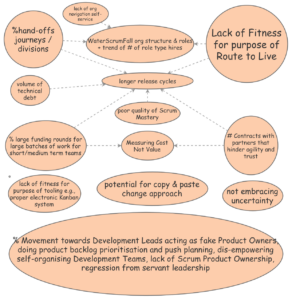Working at Toyota Taiichi Ohno developed kanban to create a just-in-time flow and reduce the inventory. The system takes its name from the signal cards that track production within a factory.
What is the Kanban Method?
While Taiichi Ohno introduced Kanban in the manufacturing industry, David J. Anderson was the first to apply the concept to IT, software development, and knowledge work in general in 2004. David built on the works by Taiichi Ohno, Eli Goldratt, Edward Demmings, Peter Drucker and others to define the Kanban Method. His first book on Kanban – “Kanban: Successfully Evolutionary Change for your Technology Business”, published in 2010, is the definition of the Kanban Method for knowledge work.
Delivering work quickly and effectively could be a challenge. Kanban is a method for designing and effectively managing knowledge work without overburdening staff, reducing the time to market and improving staff engagement.
Kanban manages work by balancing demands with available capacity, limiting the work in progress and improving the handling of system-level bottlenecks.
Kanban method
- Provides a lens through which the current ways of working are improved through understanding and evolutionary change.
- Enables you to transform your organisation through purposeful and insightful evolutionary change. The Kanban method is designed for managing and improving knowledge and creative work.
- Is applicable at all levels from senior leaders and executives who set the strategy to teams who deliver the strategy.
- Visualises both the process (the workflow) and the actual work passing through that process.
- Identifies sources of delay and enables you to tackle them to improve workflow.
- Identify bottlenecks, introduce buffers to smooth the flow, and remove the bottleneck
Kanban Visualization
Knowledge work is unlike physical goods, where we can see how the workflows and where work is piling up and getting stuck. Kanban requires making the workflows visible, which enables us to direct our attention and limited time to where it is needed most.
With this visualisation, many pieces of work will be in flight at different stages of completion, and we will be aware of this problem, resulting in very few that are entirely leading to longer lead times and poor customer service. Starting many pieces of work being busy but not finishing work leads to work stress and employee dissatisfaction and increases failure demand.
Kanban visualises the significant knowledge discovery steps. The Kanban method uses visual tokens to represent work items and creates a virtual kanban system, which makes the invisible work visible.
Kanban Focus
Multitasking dilutes the focus on what matters and what is priority. Kanban creates the necessary focus on delivering what matters by limiting the pieces of work that flow and focusing on completing a work item before starting a new one. Limiting the pieces of work reduces the opportunities for multitasking.
Kanban’s daily meeting is designed to reinforce the focus on completion of work and runs from right to left. That is, we focus on the activities required to move the work from being in progress to being done. Concentrating on finishing what we started before taking in a new piece of work creates better conditions for collaboration by making the piece of work the critical focal point for discussion and asking what we (the team) can do to deliver it.
Limiting the pieces of work that flow through the system and visualising how the work is flowing and when it is stuck creates the conditions for seeing the problems in flow and addressing the sources of the delay.
Kanban method uses work in progress as an enabling constraint to create a pull system of work and enables better work management with improved service delivery. Kanban’s service delivery lens helps you improve your service delivery and evolve your current working methods.
Kanban System Design
Each kanban system is designed based on understanding the current work system by studying it to gain the required knowledge. Kanban’s approach to understanding, developing and evolving the system of work ensures that we don’t end up with a copy and paste or a mandated recipe of best practices for everyone to follow.
Each kanban system is designed with and by the people who understand the details of how the work works, which respects the people, gains agreement to change and avoids imposed change. Kanban focuses on managing the work and not the worker.
The Kanban system creates the conditions for problem-solving by making delays to flow visible and their impact known. Kanban teaches us to understand the economics of flow in terms of transaction cost, coordination cost and failure demand and how to design an optimal work system.
Kanban System Performance
Kanban system delivery capability measures enable leaders to make better-informed decisions by understanding the organisation’s delivery capability and flow visibility.
Kanban enables individuals, teams, and departments to stop saying No, not now, with confidence, understanding and visibility of what work is in progress, when it is likely to be completed and when we will have availability for the next piece of work. Kanban balances customer demand and organisational capability to fulfil the demand.
Kanban flow measures
Lead time
Lead time measures the time from customer request to its fulfilment.
Kanban system lead time
We need more control over the rate at which customer demand arrives, Kanban system lead time measures the time from the Commit Point to delivery.
Cycle time
Any part of lead time is defined as cycle time, for example, time spent defining the customer problem through research and data analysis.
Delivery rate
Delivery rate is the rate at which work items are delivered, such as the daily number of work items.
Work In Progress
The number of work items in progress from the Commit Point to delivery.
Six Core Practices of the Kanban Method
Visualise
This is the fundamental step where the critical knowledge discovery steps, as currently practised, are visualised, and the flow of work is mapped. Most kanban systems will have more than one type of workflow across them. Two common ways to show different types of work are colour or swim lanes.
Different types of work are visualised using different colours on the board, and we can get a sense of the blend of work by the colours.
Swim lanes achieve the same result by having dedicated lanes per type of work.
Limit WIP (Work in Progress)
The Kanban system is one where the amount of work in progress (WIP) is limited; limiting WIP is fundamental in creating a pull-based work system.
By limiting WIP, we minimise the opportunity for multitasking and create the conditions for the team members to focus on finishing the work before starting something new.
Manage Flow
Kanban systems are designed to improve flow; managing and enhancing flow is the critical action required. A Kanban system helps manage flow by visualising the workflow and where the work item is. The flow of work is driven by controlling the amount of work that piles up (this signals that the arrival rate at the stage is greater than the processing rate). As the number of work items grows, so does the lead time. The WIP limits create a buffer of appropriate size that smooths the flow while at the same time ensuring that the overall lead time remains within acceptable customer expectations.
Make Process Policies Explicit
Policy constraints are a crucial cause of long lead times, and because the people within the system introduce them, we should be able to address the policy constraints that impede flow. Policies also define what must be done to a given work item at each workflow step, enabling built-in quality. Examples of explicit policies include the Definition of Done and when and how WIP limits are adjusted. Policies can apply to the system as a whole (the board), swim lanes, columns and combinations of the above.
Implement Feedback Loops
Reducing the time to feedback and increasing the number of feedback loops is the key to any sound system design.
Improve Collaboratively, Evolve Experimentally (using the scientific method)
Improve collaboratively to minimise the chances of local optimisation evolving experimentally using scientific methods through hypothesis, experiments and observation.
95% of the performance results from how the system of work is designed and managed. Dr Edward Deming
The Kanban method enables you to design and act on your system of work and significantly improve the results.
The impact of our engagements
- Reduced Time to Market by 30% to 75%
- Reduced Failure Demand by 40% to 80%
- Increased Delivery Rate by 20% to 50%
The Kanban training guides Kanban implementation and bootstrapping a Kanban system in your organisation. You will learn how Kanban is a cultural change initiative, what that shift means, how Kanban can be applied to your software development workflow, and how it differs from other development methods.
For more information on Kanban training, please click here.
Related posts
Five Steps to improve your system of work
Do you know your system capability?












